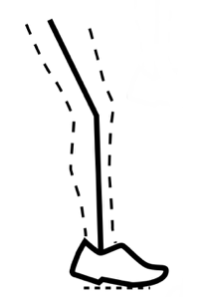Running - 3 Strikes And You’re Out… Of Action
The easiest and most accessible way to exercise this year might be just the easiest way to wind up at your physiotherapist, limping, stiff, tight and not sure why.
In previous injury blogs I have focussed on load tolerance as a factor for injury prevalence, however in this I will delve into my favourite part of Physiotherapy, which is biomechanics. I will discuss how this relates to the lower limb in running, to be specific, assessing three variations of foot strike in running technique, something that can easily be altered and possibly translate to quicker, more efficient and decreased chance of injury for all you running lovers.
In our clinic the vast majority of runners, either casual, as part of a group or competing in events such as fun runs, marathons or triathlons haven’t been taught running technique and are mostly running on instinct or self-taught.
In this blog we will focus our spotlight on research completed by Daoud, 2012 in which they explain how the bodies kinematics or body position and angles effect the internal and external forces on our muscles, joint surfaces, ligaments and tendons
So here is a very quick lesson into the types of foot strike
Rear Foot Strike (RFS): When the runner contacts the ground with the heel first
During a RFS running style, the foot will land in front of the knee and hip, with a relatively extended knee, dorsiflexed ankle (Toes/Foot pointed up towards shin), slightly inverted (Toes/Foot pointed inward) and abducted (Lateral edge of foot raised) ankle. The immediate next movement is forceful plantar flexion (Toes/Foot moving away from shin) just after impact.
Mid Foot Strike: When the runner contacts the ground with the portion of the foot between the heel and toes.
A MFS running style will be variable in regards to forces depending on the capabilities of structures above (Ankle / Knee / Hip).
Fore Foot Strike: When the runner contacts the ground with the ball of the foot or toes
FFS running style tends to land with a flexed knee and plantar-flexed ankle, making ground contact below the fourth or fifth metatarsal heads (Base of the toes). The runner that adopts this style will usually contact with more ankle and knee compliance and in theory cause less injuries due to energy being absorbed.
What does this mean for me?
Possible decrease in prevalence of injury:
It is predicted that strike type affects injury rates, where research shows the ground reaction forces of RFS landings typically generate substantial peak level of impact, a brief, high spike of force coinciding immediately after the foot’s initial contact with the ground. The higher the peak force the higher the shock going up the leg and straining the skeletal tissue.
Recent studies have shown a correlation between RFS running style and increased injury rates of stress fractures, plantar fasciitis, medial tibial stress syndrome and patello-femoral joint pain.
FFS running isn’t without its own set of ailments as technique alone cannot reduce injury incidence to 0 just like load pacing can’t reduce your injury incidence to 0. Increased loading onto the forefoot may come with it injuries to the achilles due to increased elastic loading and stress fractures of the metatarsals (Bones of the foot).
“Research Suggests”
In breaking down what Daoud and colleagues in 2012 found from this study has relevant real world application.
52 Long distance runners were assessed with both treadmill and track video analysis, with 16 being FFS runners and 36 RFS runners.
“Transparency is key for a practitioner and should be for the research that guides practice as well. Both FFS and RFS runners were injured at high rates, as running is a high load dynamic activity and all runners should be aware of what it takes to be strong enough to complete this activity and regularly. What this research highlights is the differences between the two groups supports the hypothesis that foot strike patterns influence injury rates.
THE NUMBERS
This sample of RFS runners when considering repetitive type injuries was 2.6 times more likely to have mild injuries, 2.4 times more likely to have moderate injuries and twice as likely to have a moderate or severe injury.
If we put traumatic injury rates in the spotlight there were no significant difference between RFS and FFS runners.
Predicted RFS injuries (hip pain, knee pain, lower back pain, tibial stress injuries, plantar fasciitis, and stress fractures of lower leg) were between 2 and 4 times more frequent in RFS than in FFS runners.
WHAT CAN I EXPECT OR LOOK OUT FOR IF I ALREADY HAVE A FOREFOOT STRIKE PATTERN?
If we’re being totally transparent lets talk about injuries that can come about due to FFS running type. The incidence of injuries predicted to be higher in FFS runners are as follows;
Achilles tendinopathies
Foot pain
Injuries that were as equally prevalent between strike patterns
Metatarsal (Bones of the Foot) stress fractures
CONCLUSION
Running, regardless of technique, is highly likely to pick up an injury if completed for long enough. The more inexperienced in running technique you are the more likely you are to incur some of the injuries mentioned above.
As running is one of the most widely participated activities in the world and ever increasing with how easy it is to participate in, technique is imperative for the beginner in injury prophylaxis.
If you are a keen runner or just looking to start and would like an assessment, get in touch with us or alternatively your local running club, this just may be what keeps you running on all cylinders.




